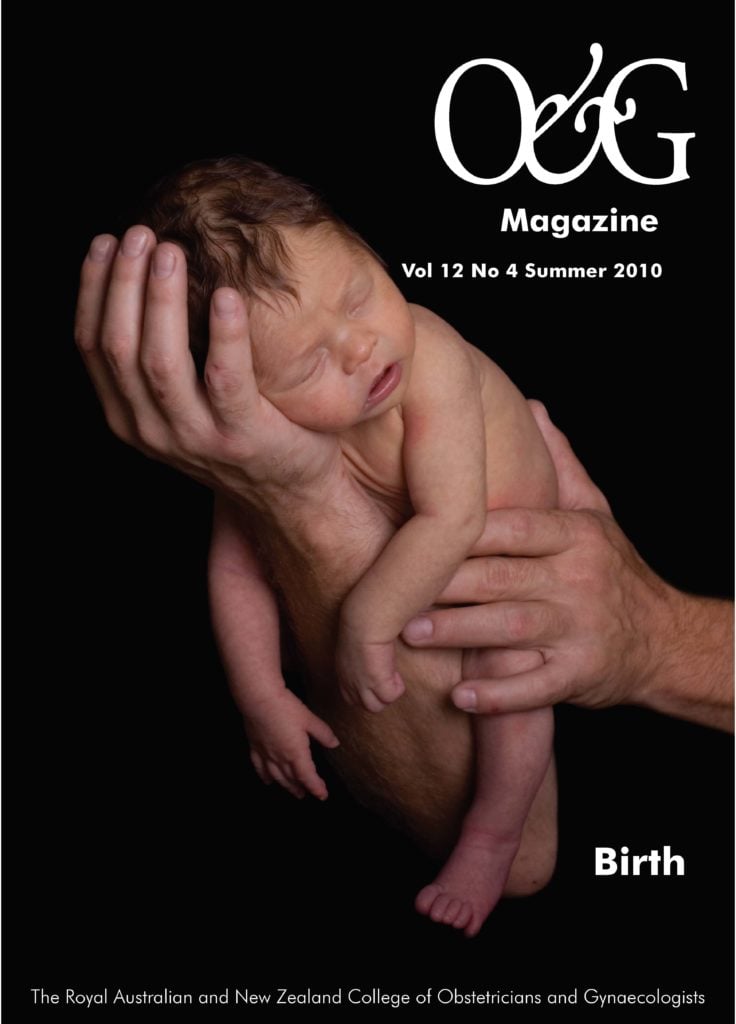Warm water immersion and, by extension, birth in water, or water birth as it is more commonly called, are contentious areas of clinical practice in maternity, with obstetricians and midwives holding often divergent views on both topics in Australia.
The Royal Australian and New Zealand College of Obstetricians and Gynaecologists (RANZCOG) produced a statement in July 2008 entitled, ‘Warm Water Immersion During Labour and Birth’1, which suggested a very cautious approach for warm water immersion and even more so for water birth. The Royal College of Obstetricians and
Gynaecologists (RCOG) and the Royal College of Midwives (RCM) have published a joint statement entitled, ‘Immersion in Water During Labour and Birth’.2 Both RCOG and RCM support labouring in water for healthy women with uncomplicated pregnancies, but do point out that the evidence to support water birth is less clear, even though serious complications for mothers and their babies are seemingly rare. They further point out that if good practice guidelines are followed in relation to infection control, management of cord rupture and strict adherence to eligibility criteria, complications should be further reduced.
In 1992, a report was produced by a House of Commons Health Committee. This was the Winterton Report, entitled Second Report on the Maternity Services. The report recommended that all maternity services provide women with the option to labour and/or give birth in water.3
New South Wales Health has recently issued a document, Towards Normal Birth in New South Wales, and one of the recommendations of that document is that there be ‘the development of written policies on normal birth and pain relief, including the use of water immersion such as birthing pools’.4
With the Federal Government’s Maternity Reforms, which took effect in November 2010, there is an increased focus on midwife care, with eligible midwives being able to care for pregnant women through the continuum of antenatal, intrapartum and postnatal care. Midwives would seem to have a different position from many obstetricians on the use of water during labour and birth. This article will focus on the rationale for the use of warm water immersion during labour and outline the experience one maternity unit had in introducing warm water immersion and water birth. There may be other ways for these differences between maternity care providers to be overcome, but, in any event, it seems important these days to provide informed choice for women to meet their perceived needs, while still trying, within the ambit of that choice, to ensure safe practice and excellent outcomes for maternity care.
The use of warm water immersion during labour
It seems clear that the use of warm water immersion during labour promotes a sense of relaxation and buoyancy for some women, who then find that the pain of labour is more tolerable, thus making them able to use less pharmacological analgesia. The most recent evidence in the Cochrane Library database was published by Cluett and colleagues in 2009.5 They concluded that immersion in water during the first stage of labour significantly reduced women’s perception of pain and the use of epidural and spinal analgesia. They found no evidence of increased adverse effects to the fetus or the woman from labouring in water, but did point out that there was limited information for other outcomes other than the reduced use of epidural/spinal analgesia, because of intervention and outcome variability. Despite that, they found no evidence of increased adverse effects to the neonate from water birth. They further pointed out that the use of water immersion in labour and birth is now widely available and this fact threatens the feasibility of a large multicentre randomised control trial on the subject.
The Cochrane Review suggests, as does the RANZCOG statement, that warm water immersion and water birth should be subjected to critical audit. There should also be an obligation on units utilising these practices to publish their data.
Eligibility criteria for use of water in labour and birth
Most of the available evidence from both randomised trials and observational data suggests that healthy women with an uncomplicated pregnancy at term should be allowed warm water immersion, with prior informed consent. This would mean that women would have to have a singleton pregnancy; no other risk factors or problems during labour; preferably have clear liquor; and have no other requirement for continuous electronic fetal monitoring (EFM) during labour. Continuous EFM can be done done by telemetry, allowing women warm water immersion, but this is not always available in all centres.
Other contraindications include women with a term weight of 100 kg or greater, as there are workplace health and safety issues in removing a woman greater than 100 kg from the bath in the event of unexpected maternal collapse or other obstetric calamity; inability to provide hot, clean tap water; the need for other pharmacological analgesic agents; maternal exhaustion; and poor progress in labour.
It is incumbent on units practising warm water immersion and water birth to ensure that they have fail-safe mechanisms for ensuring that women can be retrieved from the bath during an emergency. This should be something that is regularly audited and practised to ensure faultless performance when required.
Birth in water
Properly informed choice on the benefits or risks of birth in water is not possible because there is a lack of good-quality safety data. At present, there is no evidence of higher perinatal mortality or extra morbidity from water inhalation or near drowning. Most units practising water birth do not report extra admissions to special care baby units. However, there are potential problems with this. Because of small numbers, under reporting and missed diagnosis are possible. A number of reviews6,7 have identified some rare complications associated with water birth.
How to fit warm water immersion and water birth into a collaborative model of maternity care
This clinical problem confronted the obstetricians who work at the Nambour Selangor Private Hospital on the Sunshine Coast in Queensland. The maternity unit medical and midwifery staff had instituted a collaborative model of maternity care at the unit’s inception in 1997. This model was chosen as it offered, in the collective view, the best chance for workplace harmony, respectful practice and the chance of the best outcomes for mothers and babies cared for in the unit.
At the time of consideration of introduction of a warm water immersion and water birth policy, the maternity unit manager (MUM) and the midwives were very keen on its introduction. None of the obstetricians had any experience with these practices. After initial discussion, and no agreement about the introduction of any policy, both obstetricians and midwives did a literature search, spoke to practitioners engaged in warm water immersion and water birth, and eventually agreed on a written policy. The unit’s paediatricians were involved and also gave guarded agreement to the policy. The MUM developed a learning package for the clinical staff and preceptored a number of midwives about warm water immersion. Specific training was focused on rare emergencies.8 A commitment was made that every water birth be reviewed at the weekly unit audit meeting, which was multidisciplinary, to review maternal and neonatal outcomes. A commitment was made to keep data retrospectively, to enable an adequate review of outcomes for mothers and babies. Following the first 700 water births, the data were compared to 700 matched conventional births. Owing to some difficulties with data being incomplete, this ended up being a study comparing 690 water births against 690 conventional births over a six-year time span.
The study ended up as a retrospective comparative analysis, with each water birth being matched with the next birth in the birth register, matching for primigravida status, previous caesarean section, and previous spontaneous or assisted vaginal birth. There was little difference in patient demographics, but in the water birth group, there was more spontaneous labour, less augmentation of labour, the mothers were less likely to have oxytocics in the third stage, and less likely to allow the babies to be given Konakion. The water birth group also seemed to have shorter labours and less blood loss, but this did not reach clinical significance.
There was no difference in nursery admissions. There were no babies admitted to the nursery with water inhalation and there was no increase in neonatal sepsis.
Virtually all the babies in both groups were being breastfed on discharge, and maternal satisfaction was very high, with almost all women who had a water birth saying they would definitely do it again.
The conclusions drawn from the study were that:
- Women who had a water birth seemed to have straightforward, low-intervention labours.
- Water birth outcomes were comparable or better than conventional births.
- No extra risk or poorer outcome was identified for the mothers or babies.
- Clinicians were happy that warm water immersion and water birth be considered as an option for low-risk women in labour.
- Regular multidisciplinary clinical audit was essential.
A key to this has been the training and mentoring of staff in use of water in labour. The study though suffers from all the problems of a retrospective analysis, but does provide a useful snapshot of a change in clinical practice that was introduced collaboratively, with good audit and outcomes. Consideration was given to doing a prospective, randomised trial, but this was felt to be difficult9 and outside the scope of the unit to perform it adequately, with the large numbers required to show a difference.
Should warm water immersion and water birth be more generally available?
This is a difficult question to answer. The way that it evolved, as described above, worked for the maternity unit at Nambour Selangor Private Hospital, but depending on opinions, biases and experience of the clinicians involved, both medical and midwifery, it may not be as successful in other units. There are costs in having a warm water immersion program, with a lot of extra plumbing and hoisting apparatus being required, and this may preclude its uptake in some places.
All that aside, the satisfaction data obtained from the mothers was overwhelmingly positive. Many women now travel significant distances to avail themselves of this service, which is often unobtainable elsewhere in south Queensland. The neonatal outcomes seem as good, or better, than conventional birth in Nambour Selangor Private Hospital.
Clearly, these issues will only be resolved with respectful discussion and collaboration between different maternity care providers, taking into account the potential choices the women who utilise their birthing services may have.
References
- Immersion in Water During Labour and Birth (RCOG/Royal College of Midwives Joint Statement No. 1) Access at: www.ranzcog.edu.au/publications/statements/C-Obs-24.pdf .
- Warm Water Immersion during Labour and Birth Access at: www.rcog.org.uk/womens-health/clinical-guidance/immersion-water-during-labour-and-birth [link expired; please search www.rcog.org.uk/en/guidelines-research-services/].
- House of Commons Health Committee. Second Report on the Maternity Services (Winterton Report). London: HMSO; 1992.
- Maternity – Towards Normal Birth in NSW Access at: www.health.nsw.gov.au/policies/pd/2010/PD2010_045.html – 17k – Cached – 29 Jun 2010
- Citation: Cluett ER, Burns E. Immersion in water in labour and birth. Cochrane Database of Systematic Reviews 2009, Issue 2. Art. No.: CD000111. DOI: 10.1002/14651858.CD000111.pub3.
- Anderson T. Umbilical cords and underwater birth. Practising Midwife 2000; 3(2):12.
- Gilbert RE, Tookey PA. Perinatal mortality and morbidity among babies delivered in water: surveillance study and postal survey. BMJ 1999; 319:483-7.
- Grunebaum A, Chervenak FA. The baby or the bathwater: which one should be discarded? J Perinat Med. 2004; 32:306-7.
- Woodward J, Kelly SM. A pilot study for a randomised controlled trial of water birth versus land birth. BJOG 2004; 111:537-45.






Leave a Reply